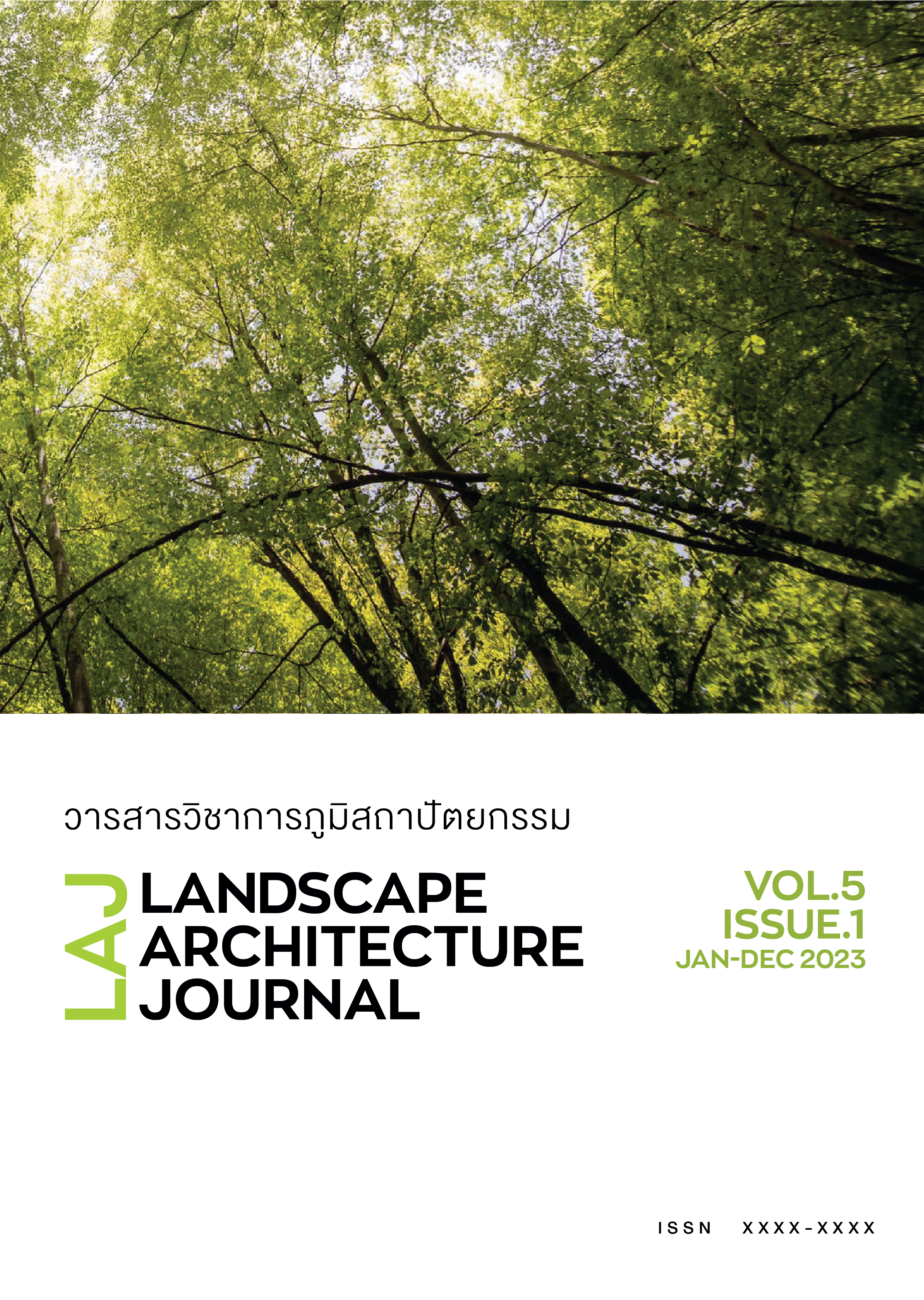Hydrologic Processes and Local Livelihood Study with Landscape Ecology Framework in Rural Agricultural Communities in Tambon Bang Toei, Muang Phang Nga, Phang Nga
Main Article Content
Abstract
Landscape Ecology is fundamental to studying the hydrological processes of agricultural communities in rural areas. Communities in rural areas depend on natural processes and products. The study method uses the landscape ecology concept to analyze the study area. The landscape's structures, functions, and changes must be described with the primary and secondary data. Hydrological processes are the main functions that define ecosystem services the landscape provides. The study area is a coastal community adjacent to Phang Nga Bay. The results revealed that this area is influenced by precipitation and tidal, which are conditions of the community's way of life. The effect of unsuitable development will cause uncertain life and deteriorate resources. The findings from landscape hydrological processes are used for resource management systems based on landscape ecology concepts and social mechanisms. The suggestions come in two scales. First, resource management in a cluster of villages relates to landscape conditions: valley, coastal, and estuary areas. Second, the watershed scale, which includes all villages in the study area. Our framework will support a self-governance community and maintain landscape processes and community well-being.
Article Details

This work is licensed under a Creative Commons Attribution-NonCommercial-NoDerivatives 4.0 International License.
References
งานวางแผนสถิติและวิชาการ สำนักปลัดเทศบาลตำบลบางเตย. (2561). แผนพัฒนาท้องถิ่น พ.ศ. 2561-2565 เพิ่มเติมและเปลี่ยนแปลง ฉบับที่ 4. สืบค้นจาก https://bangtoeycity.go.th/public/list/data/detail/id/3572/menu/1196/page/1/catid/2
ทัศนีย์ ศุภพฤกษ์, วิทยา พันธะกิจ, สุชาติ แสงจันทร์, และ เทิดศักดิ์ มิตรวงค์. (2559). เครื่องมือลอบพื้นบ้านในจังหวัดพังงา. ภูเก็ต : ศูนย์วิจัยและพัฒนาประมงทะเลฝั่งอันดามัน (ภูเก็ต).
สุจารี ไชยบุญ. (2552). ล่องคลองพังงา (ตอนที่1) ตอน ย้อนอดีตเมืองเหมืองแร่. หนังสือพิมพ์ภูเก็ตโพสต์.
อรกมล นิละนนท์, อัตนา วสุวัฒนะ, และ นักรบ สายเทพ. (2566). โครงการศึกษาภูมินิเวศชนบท สำหรับการพัฒนาพื้นที่สัมพันธ์กับระบบนิเวศและวิถีชีวิต [เอกสารไม่ตีพิมพ์]. กรุงเทพฯ : สถาบันพัฒนาองค์กรชุมชน (องค์การมหาชน).
Ahern, J. (1999). Spatial Concepts, Planning Strategies, and Future Scenarios: A Framework Method for Integrating Landscape Ecology and Landscape Planning. In Landscape Ecological Analysis (pp. 175–201). Springer New York. https://doi.org/10.1007/978-1-4612-0529-6_10
Forman, R. T. T. (1995). Land mosaics: The ecology of landscapes and regions.
Forman, R. T. T., & Godron, M. (1986). Landscape Ecology. Wiley.
IUCN. (2020). Guidance for using the IUCN Global Standard for Nature-based Solutions. https://doi.org/10.2305/IUCN.CH.2020.08.en
Marsh, W. M. (2005). Landscape planning: Environmental Application (Fourth Edi).
Marsh, W. M., & Dozier, J. (1981). Landscape: An Introduction to Physical Geography.
MEA. (2005). Ecosystems and Human well-being. Island Press.
Nassauer, J. (1997). Placing Nature. In Culture and Landscape Ecology. Island, Covelo. http://scholar.google.com/scholar?hl=en&btnG=Search&q=intitle:placing+nature#4
Plieninger, T., van der Horst, D., Schleyer, C., & Bieling, C. (2014). Sustaining ecosystem services in cultural landscapes. Ecology and Society, 19(2). https://doi.org/10.5751/ES-06159-190259
Pretty, J. (2002). Agri-culture : reconnecting people, land and nature.
Pretty, J., Adams, B., Berkes, F., Ferreira de Athayde, S., Nigel Dudley, Eugene Hunn, Luisa Maffi, Kay Milton, David Rapport, Paul Robbins, Eleanor Sterling, Sue Stolton, Anna Tsing, Erin Vintinner, & Sarah Pilgrim. (2009). The Intersections of Biological Diversity and Cultural Diversity: Towards Integration. Conservation and Society, 7(2), 100–112.
Steinitz, C. (1995). A framework for planning practice and education. Ecological Landscape Planning, 42–54.
Takeuchi, K., Ichikawa, K., & Elmqvist, T. (2016). Satoyama landscape as social–ecological system: historical changes and future perspective. Current Opinion in Environmental Sustainability, 19, 30–39. https://doi.org/10.1016/j.cosust.2015.11.001.
Thailand Tide Tables. (2022). ตารางน้ำขึ้น น้ำลง ปากน้ำกระบี่. สืบค้นจาก Https://Www.Thailandtidetables.Com/ไทย/ตารางน้ำขึ้นน้ำลง-ปากน้ำกระบี่-กระบี่-462.Php.
Turner, M. G. (1989). LANDSCAPE ECOLOGY: The Effect of Pattern on Process. In Annu. Rev. Ecol. Syst (Vol. 20).
United Nations Environment Programme. (1997). Global Environment Outlook.
Water Science School. (2019). Surface Runoff and the Water Cycle. https://www.usgs.gov/special-topics/water-science-school/science/surface-runoff-and-water-cycle
Zonneveld, I. S. (1995). Land Ecology: An Introduction to Landscape Ecology as a Base for Land Evaluation, Land Management & Conservation.

